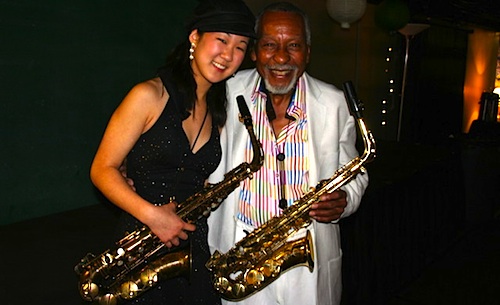By Joe Bendel. What was someone as young and talented as jazz musician Grace Kelly doing in San Quentin? She was playing in a unique tribute concert for Frank Morgan, her late, great mentor. Morgan himself was always the first to admit he spent far too much time incarcerated there, due to drugs and flawed decision-making. However, Morgan finally left prison for good in 1985 just in time for a mini-renaissance of interest in the old school bop tradition. N.C. Heiken’s chronicles his tumultuous life and beautiful music in The Sound of Redemption: the Frank Morgan Story, which screens this Sunday as part of Sound + Vision 2015.
In a way, music was in Morgan’s blood. He was the son of Ink Spots member Stanley Morgan, but that was a decidedly mixed blessing. Frank Morgan heard Charlie Parker at a young age and was profoundly influenced by his music. Unfortunately, he also developed a Bird-like heroin habit. Like most junkies, Morgan resorted to crime to pay for his habit, but he was especially industrious and/or reckless.
There was indeed a time when people considered the sixteen piece San Quentin Warden’s Band the best big band in California without any intended irony. For years, it was his only gig. Despite all his promise, Morgan was nearly unknown beyond the circle of musicians who played with him when he was literally just a kid, or had had their own stint in the San Quentin Band.
Man, the 1980s were a good decade, especially for real deal jazz greats like Morgan. However, Morgan’s third act not one of absolutely unalloyed triumphalism. In fact, Heikin nicely tempers the inspirational with the darker backsliding realities of life. Things were as they were, but the music remains.
At the heart of the film is the rather remarkable concert featuring Morgan’s friends and colleagues, performing the standards he was most associated with. Even though we do not hear the man himself in these sequences, they have the right spirit nonetheless. They are also very shrewdly edited. In one memorable scene, we clearly see one resident audience member nodding along knowingly as trombonist and master-of-ceremonies Delfeayo Marsalis explains just how much Morgan lost as a result of his habit.

Heikin is also wise enough to show Kelly’s absolutely devastating performance of “Somewhere Over the Rainbow” in its uninterrupted entirety. Frankly, seeing her in front of that rough-looking crowd will alarm a lot of us jazz fans who remember her as the twelve year-old prodigy who exploded onto the scene (with Morgan’s encouragement), but she is in her early twenties now. Regardless, her rendition is exquisitely fitting. Morgan was inspired by Bird, but he had a tender way with ballads that was more like an alto version of Dexter Gordon (a former Central Avenue comrade).
By following up the chilling yet strangely elegant North Korean expose Kimjongilia with her sensitive and swinging portrait of Morgan, Heikin might just become our new favorite filmmaker. Her instincts are sharp and reliable, while her aesthetic sensibilities are unerringly sophisticated. Executive produced by hipper-than-you-knew mystery novelist Michael Connelly, Sound of Redemption does right by its subject, as well as his fellow musicians (especially including Kelly, Marsalis, pianist George Cables, legendary bassist Ron Carter, drummer Marvin “Smitty” Smith, and alto player Mark Gross, who all gigged on the central prison concert, sounding fantastic). A bittersweet treat, Sound of Redemption is very highly recommended when it screens this Sunday (8/2) at the Walter Reade, as part of this year’s Sound + Vision.
LFM GRADE: A
Posted on August 1st, 2015 at 3:42pm.